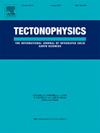巴尔干山脉外部的变质基底构造和阿尔卑斯剪切带:保加利亚斯塔拉普兰纳山脉中部维珍山丘的构造数据
IF 2.7
3区 地球科学
Q2 GEOCHEMISTRY & GEOPHYSICS
引用次数: 0
摘要
保加利亚的阿尔卑斯山巴尔干山脉发育在瓦里斯山造山运动片段之上,这些片段受到晚期厚皮推覆构造的不同影响。通常情况下,这些碎块同时保留了瓦里斯山和阿尔卑斯山的构造记录。Alpine Balkanide 造山带外部构造演化的重要方面的一个关键地区是位于 Stara Planina 山脉中部的 Vezhen 地块。虽然它完全由古生代结晶岩构成,但其结构长期以来一直被认为是始新世中期到渐新世早期(阿尔卑斯山晚期)强烈缩短的典范。在该地区进行的详细实地考察显示了一个更为复杂的构造框架,并提供了多阶段构造演化的证据,其中包括一个重要的瓦里斯坎变质和变形阶段,以及两个北伸的阿尔卑斯山缩短阶段。影响维珍山丘西部的斯塔盖尔-波卢万亚构造带是巴尔干褶皱推覆带中最重要的瓦里斯山构造之一。构造数据表明,变质基底记录了最初的自上而下的推力,随后进一步缩短,导致褶皱和局部走向滑动变形。瓦里斯坎期的同步变质构造被几个石炭纪晚期至二叠纪的后激变火成岩体交叉切割。构造历史继续发展,形成了绿泥石面北向隆起的熔岩带网络,假定其年代为阿尔卑斯山早期(二叠纪晚期之后,白垩纪晚期之前)。阿尔卑斯山晚期的北向推力仅在卫镇山丘的东侧和北侧较为明显。从广义的构造角度来看,织金山丘基底岩石的文献记录与阿尔卑斯山和伊比利亚山丘的外部记录相当。本文章由计算机程序翻译,如有差异,请以英文原文为准。

Variscan basement tectonics and Alpine shear zones in the external Balkanides: Structural data from the Vezhen Massif, Central Stara Planina Mts., Bulgaria
The Alpine Balkanides in Bulgaria are developed over Variscan orogenic fragments, which are variously affected by late-stage thick-skinned thrust tectonics. Often, these fragments hold both Variscan and Alpine structural records. А key area to shed light on important aspects of the tectonic evolution of the external parts of the Alpine Balkanide orogen is the Vezhen Massif in the Central Stara Planina Mountains. Although it is built exclusively of Paleozoic crystalline rocks, its structure was long considered as an example of intense mid Eocene to early Oligocene (Late Alpine) shortening. Detailed fieldwork in the area shows a more complicated tectonic framework and provides evidence of a polyphase structural evolution, involving an important stage of Variscan metamorphism and deformation and two stages of north-vergent Alpine shortening. The Stargel-Boluvanya Tectonic Zone that affects the western Vezhen Massif is one of the most important Variscan structures in the Balkan fold-and-thrust belt. Structural data indicate that the metamorphic basement records initial top-to-north thrusting, followed by further shortening, which led to folding and localized strike-slip deformation. The Variscan syn-metamorphic fabric is cross-cut by several post-kinematic igneous bodies of late Carboniferous to Permian ages. The tectonic history continues with a development of a network of greenschist facies north-vergent mylonitic zones for which an Early Alpine (post-late Permian but pre-Late Cretaceous) age is assumed. Late Alpine north-vergent thrusting is evident only on the eastern and northern flanks of the Vezhen Massif. In a broad structural context, the documented record in the basement rocks of the Vezhen Massif is comparable with those of the external massifs of the Alps and Iberia.
求助全文
通过发布文献求助,成功后即可免费获取论文全文。
去求助
来源期刊

Tectonophysics
地学-地球化学与地球物理
CiteScore
4.90
自引率
6.90%
发文量
300
审稿时长
6 months
期刊介绍:
The prime focus of Tectonophysics will be high-impact original research and reviews in the fields of kinematics, structure, composition, and dynamics of the solid arth at all scales. Tectonophysics particularly encourages submission of papers based on the integration of a multitude of geophysical, geological, geochemical, geodynamic, and geotectonic methods
 求助内容:
求助内容: 应助结果提醒方式:
应助结果提醒方式:


